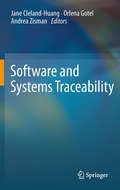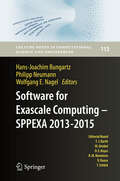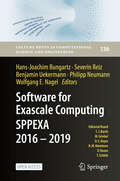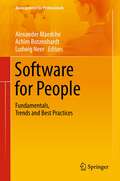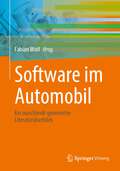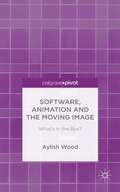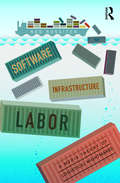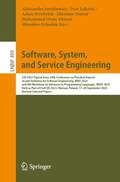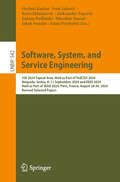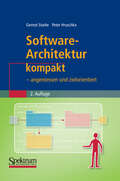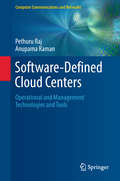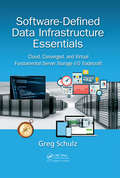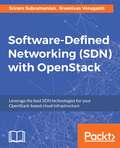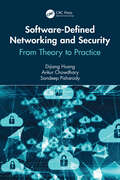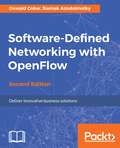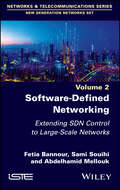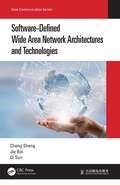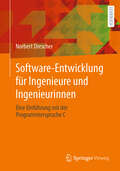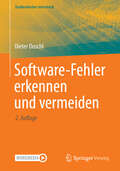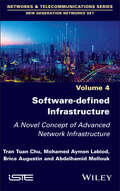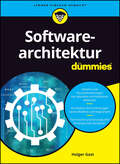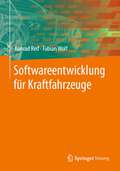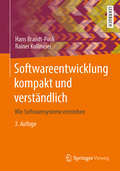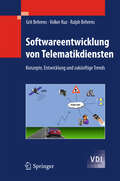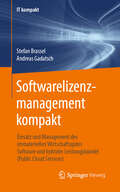- Table View
- List View
Software and Systems Traceability
by Orlena Gotel Jane Huang Andrea ZismanSoftware and Systems Traceability provides a comprehensive description of the practices and theories of software traceability across all phases of the software development lifecycle. The term software traceability is derived from the concept of requirements traceability. Requirements traceability is the ability to track a requirement all the way from its origins to the downstream work products that implement that requirement in a software system. Software traceability is defined as the ability to relate the various types of software artefacts created during the development of software systems. Traceability relations can improve the quality of a product being developed, and reduce the time and cost of development. More specifically, traceability relations can support evolution of software systems, reuse of parts of a system by comparing components of new and existing systems, validation that a system meets its requirements, understanding of the rationale for certain design and implementation decisions, and analysis of the implications of changes in the system.
Software for Exascale Computing - SPPEXA 2013-2015
by Hans-Joachim Bungartz Wolfgang E. Nagel Philipp NeumannThe research and its outcomes presented in this collection focus on various aspects of high-performance computing (HPC) software and its development which is confronted with various challenges as today's supercomputer technology heads towards exascale computing. The individual chapters address one or more of the research directions (1) computational algorithms, (2) system software, (3) application software, (4) data management and exploration, (5) programming, and (6) software tools. The collection thereby highlights pioneering research findings as well as innovative concepts in exascale software development that have been conducted under the umbrella of the priority programme "Software for Exascale Computing" (SPPEXA) of the German Research Foundation (DFG) and that have been presented at the SPPEXA Symposium, Jan 25-27 2016, in Munich. The book has an interdisciplinary appeal: scholars from computational sub-fields in computer science, mathematics, physics, or engineering will find it of particular interest.
Software for Exascale Computing - SPPEXA 2016-2019 (Lecture Notes in Computational Science and Engineering #136)
by Hans-Joachim Bungartz Wolfgang E. Nagel Philipp Neumann Severin Reiz Benjamin UekermannThis open access book summarizes the research done and results obtained in the second funding phase of the Priority Program 1648 "Software for Exascale Computing" (SPPEXA) of the German Research Foundation (DFG) presented at the SPPEXA Symposium in Dresden during October 21-23, 2019. In that respect, it both represents a continuation of Vol. 113 in Springer’s series Lecture Notes in Computational Science and Engineering, the corresponding report of SPPEXA’s first funding phase, and provides an overview of SPPEXA’s contributions towards exascale computing in today's sumpercomputer technology. The individual chapters address one or more of the research directions (1) computational algorithms, (2) system software, (3) application software, (4) data management and exploration, (5) programming, and (6) software tools. The book has an interdisciplinary appeal: scholars from computational sub-fields in computer science, mathematics, physics, or engineering will find it of particular interest.
Software for People: Fundamentals, Trends and Best Practices
by Achim Botzenhardt Alexander Maedche Ludwig NeerThe highly competitive and globalized software market is creating pressure on software companies. Given the current boundary conditions, it is critical to continuously increase time-to-market and reduce development costs. In parallel, driven by private life experiences with mobile computing devices, the World Wide Web and software-based services, peoples' general expectations with regards to software are growing. They expect software that is simple and joyful to use. In the light of the changes that have taken place in recent years, software companies need to fundamentally reconsider the way they develop and deliver software to their customers. This book introduces fundamentals, trends and best practices in the software industry from a threefold perspective which equally takes into account design, management, and development of software. It demonstrates how cross-functional integration can be leveraged by software companies to successfully build software for people. Professionals from business and academia give an overview on state-of-the-art knowledge and report on key insights from their real-life experience. They provide guidance and hands-on recommendation on how to create winning products. This combined perspective fosters the transfer of knowledge between research and practice and offers a high practical value for both sides. The book targets both, practitioners and academics looking for successfully building software in the future. It is directed at Managing Directors of software companies, Software Project Managers, Product Managers and Designers, Software Developers as well as academics and students in the area of Software and Information Systems Engineering, Human Computer Interaction (HCI), and Innovation Management.
Software im Automobil: Ein maschinell-generierter Literaturüberblick
by Fabian WolfDieses Fach- und Lehrbuch enthält die maschinengenerierten Zusammenfassungen einer Datenbankrecherche zum Thema „Software im Automobil“. Die Vorgabe der Stichworte, die Struktur und die Selektion der Inhalte wurde vom Autor vorgenommen. Darüber hinaus hat der Autor die enthaltenen Artikel durch Einleitungen und Bewertungen in einen übergreifenden Zusammenhang gebracht und kommentiert. Auf diese Weise ist ein Werk entstanden, das Studierenden sowie Berufseinsteigern einen breiten Überblick über das fachliche Feld sowie Hinweise zur weiterführenden Literatur gibt und auf die weitere Arbeit in diesem Bereich vorbereitet.
Software, Animation and the Moving Image: What’s in the Box?
by Aylish WoodSoftware, Animation and the Moving Image brings a unique perspective to the study of computer-generated animation by placing interviews undertaken with animators alongside an analysis of the user interface of animation software. Wood develops a novel framework for considering computer-generated images found in visual effects and animations.
Software, Infrastructure, Labor: A Media Theory of Logistical Nightmares
by Ned RossiterInfrastructure makes worlds. Software coordinates labor. Logistics governs movement. These pillars of contemporary capitalism correspond with the materiality of digital communication systems on a planetary scale. Ned Rossiter theorizes the force of logistical media to discern how subjectivity and labor, economy and society are tied to the logistical imaginary of seamless interoperability. Contingency haunts logistical power. Technologies of capture are prone to infrastructural breakdown, sabotage, and failure. Strategies of evasion, anonymity, and disruption unsettle regimes of calculation and containment. We live in a computational age where media, again, disappear into the background as infrastructure. Software, Infrastructure, Labor intercuts transdisciplinary theoretical reflection with empirical encounters ranging from the Cold War legacy of cybernetics, shipping ports in China and Greece, the territoriality of data centers, video game design, and scrap metal economies in the e-waste industry. Rossiter argues that infrastructural ruins serve as resources for the collective design of blueprints and prototypes demanded of radical politics today.
Software, System, and Service Engineering: S3E 2023 Topical Area, 24th Conference on Practical Aspects of and Solutions for Software Engineering, KKIO 2023, and 8th Workshop on Advances in Programming Languages, WAPL 2023, Held as Part of FedCSIS 2023, Warsaw, Poland, 17–20 September 2023, Revised Selected Papers (Lecture Notes in Business Information Processing #499)
by Adam Przybyłek Aleksander Jarzębowicz Ivan Luković Mirosław Staroń Muhammad Ovais Ahmad Mirosław OchodekThis book constitutes the refereed proceedings of the S3E 2023 Topical Area, 24th Conference on Practical Aspects of and Solutions for Software Engineering, KKIO 2023, and 8th Workshop on Advances in Programming Languages, WAPL 2023, as Part of FedCSIS 2023, held in Warsaw, Poland, during September 17–20, 2023. The 6 revised papers presented in this book were carefully reviewed and selected from a total of 55 submissions. They focus on new ideas and developments in practical aspects and solutions for software engineering.
Software, System, and Service Engineering: S3E 2024 Topical Area, Held as Part of FedCSIS 2024, Belgrade, Serbia, 8–11 September, 2024 and KKIO 2024, Held as Part of SEAA 2024, Paris, France, August 28-30, 2024, Revised Selected Papers (Lecture Notes in Business Information Processing #542)
by Adam Przybyłek Ivan Luković Mirosław Staroń Geylani Kardas Boris Milašinović Aleksandar Popović Łukasz Radliński Jakub SwachaThis book constitutes selected and enlarged versions of papers presented at S3E 2024 Topical Area, held as part of FedCSIS 2024, in Belgrade, Serbia, 8–11 September, 2024 and the 25th Conference on Practical Aspects of and Solutions for Software Engineering, KKIO 2024, held as part of SEAA 2024, Paris, France, during August 28-30, 2024. The 3 papers included from KKIO 2024 were selected from 18 submissions (and 10 presentations), and the 5 papers from S3E were selected from 25 submissions (and 12 presentations). The contributions deal with academic research and real-world applications in the field of software engineering.
Software-Architektur kompakt: - angemessen und zielorientiert
by Peter Hruschka Gernot StarkeSoftware Architektur kompakt gibt Ihnen alles, was Sie zu einem reibungslosen und schnellen Start in das Thema benötigen. Lernen Sie Systeme zukunftssicher, flexibel und transparent zu konstruieren. Sie finden hier sofort einsetzbare und erprobte Muster und Vorlagen zur Erstellung praxistauglicher IT-Architekturen. Das Buch liefert allen relevanten Projektbeteiligten maßgeschneiderte Antworten zu Entwurfsentscheidungen, Systemstruktur und Implementierung.
Software-Defined Cloud Centers: Operational And Management Technologies And Tools (Computer Communications and Networks)
by Pethuru Raj Anupama RamanThis practical text/reference provides an exhaustive guide to setting up and sustaining software-defined data centers (SDDCs). Each of the core elements and underlying technologies are explained in detail, often supported by real-world examples. The text illustrates how cloud integration, brokerage, and orchestration can ensure optimal performance and usage of data resources, and what steps are required to secure each component in a SDDC. The coverage also includes material on hybrid cloud concepts, cloud-based data analytics, cloud configuration, enterprise DevOps and code deployment tools, and cloud software engineering.Topics and features: highlights how technologies relating to cloud computing, IoT, blockchain, and AI are revolutionizing business transactions, operations, and analytics; introduces the concept of Cloud 2.0, in which software-defined computing, storage, and networking are applied to produce next-generation cloud centers; examines software-defined storage for storage virtualization, covering issues of cloud storage, storage tiering, and deduplication; discusses software-defined networking for network virtualization, focusing on techniques for network optimization in data centers; reviews the qualities and benefits of hybrid clouds, that bridge private and public cloud environments; investigates the security management of a software-defined data center, and proposes a framework for managing hybrid IT infrastructure components; describes the management of multi-cloud environments through automated tools, and cloud brokers that aim to simplify cloud access, use and composition; covers cloud orchestration for automating application integration, testing, infrastructure provisioning, software deployment, configuration, and delivery.This comprehensive work is an essential reference for all practitioners involved with software-defined data center technologies, hybrid clouds, cloud service management, cloud-based analytics, and cloud-based software engineering.
Software-Defined Data Infrastructure Essentials: Cloud, Converged, and Virtual Fundamental Server Storage I/O Tradecraft
by Greg SchulzSoftware-Defined Data Infrastructures Essentials provides fundamental coverage of physical, cloud, converged, and virtual server storage I/O networking technologies, trends, tools, techniques, and tradecraft skills. From webscale, software-defined, containers, database, key-value store, cloud, and enterprise to small or medium-size business, the book is filled with techniques, and tips to help develop or refine your server storage I/O hardware, software, and services skills. Whether you are new to data infrastructures or a seasoned pro, you will find this comprehensive reference indispensable for gaining as well as expanding experience with technologies, tools, techniques, and trends. We had a front row seat watching Greg present live in our education workshop seminar sessions for ITC professionals in the Netherlands material that is in this book. We recommend this amazing book to expand your converged and data infrastructure knowledge from beginners to industry veterans. —Gert and Frank Brouwer, Brouwer Storage Consultancy Software-Defined Data Infrastructures Essentials provides the foundational building blocks to improve your craft in serval areas including applications, clouds, legacy, and more. IT professionals, as well as sales professionals and support personnel, stand to gain a great deal by reading this book.—Mark McSherry, Oracle Regional Sales Manager Looking to expand your data infrastructure IQ? From CIOS to operations, sales to engineering, this book is a comprehensive reference, a must read for IT infrastructure professionals, beginners to seasoned experts.—Tom Becchetti, Advisory Systems Engineer Greg Schulz has provided a complete ‘toolkit’ for storage management along with the background and framework for the storage or data infrastructure professional or those aspiring to become one.—Greg Brunton, Experienced Storage and Data Management Professional
Software-Defined Networking (SDN) with OpenStack
by Sriram Subramanian Sreenivas VorugantiLeverage the best SDN technologies for your OpenStack-based cloud infrastructure About This Book * Learn how to leverage critical SDN technologies for OpenStack Networking APIs via plugins and drivers * Champion the skills of achieving complete SDN with OpenStack with specific use cases and capabilities only covered in this title * Discover exactly how you could implement cost-effective OpenStack SDN integration for your organization Who This Book Is For Administrators, and cloud operators who would like to implement Software Defined Networking on OpenStack clouds. Some prior experience of network infrastructure and networking concepts is assumed. What You Will Learn * Understand how OVS is used for Overlay networks * Get familiar with SDN Controllers with Architectural details and functionalities * Create core ODL services and understand how OpenDaylight integrates with OpenStack to provide SDN capabilities * Understand OpenContrail architecture and how it supports key SDN functionality such as Service Function Chaining (SFC) along with OpenStack * Explore Open Network Operating System (ONOS) - a carrier grade SDN platform embraced by the biggest telecom service providers * Learn about upcoming SDN technologies in OpenStack such as Dragonflow and OVN In Detail Networking is one the pillars of OpenStack and OpenStack Networking are designed to support programmability and Software-Defined Networks. OpenStack Networking has been evolving from simple APIs and functionality in Quantum to more complex capabilities in Neutron. Armed with the basic knowledge, this book will help the readers to explore popular SDN technologies, namely, OpenDaylight (ODL), OpenContrail, Open Network Operating System (ONOS) and Open Virtual Network (OVN). The first couple of chapters will provide an overview of OpenStack Networking and SDN in general. Thereafter a set of chapters are devoted to OpenDaylight (ODL), OpenContrail and their integration with OpenStack Networking. The book then introduces you to Open Network Operating System (ONOS) which is fast becoming a carrier grade SDN platform. We will conclude the book with overview of upcoming SDN projects within OpenStack namely OVN and Dragonflow. By the end of the book, the readers will be familiar with SDN technologies and know how they can be leveraged in an OpenStack based cloud. Style and approach A hands-on practical tutorial through use cases and examples for Software Defined Networking with OpenStack.
Software-Defined Networking and Security: From Theory to Practice (Data-Enabled Engineering)
by Dijiang Huang Ankur Chowdhary Sandeep PisharodyThis book provides readers insights into cyber maneuvering or adaptive and intelligent cyber defense. It describes the required models and security supporting functions that enable the analysis of potential threats, detection of attacks, and implementation of countermeasures while expending attacker resources and preserving user experience. This book not only presents significant education-oriented content, but uses advanced content to reveal a blueprint for helping network security professionals design and implement a secure Software-Defined Infrastructure (SDI) for cloud networking environments. These solutions are a less intrusive alternative to security countermeasures taken at the host level and offer centralized control of the distributed network. The concepts, techniques, and strategies discussed in this book are ideal for students, educators, and security practitioners looking for a clear and concise text to avant-garde cyber security installations or simply to use as a reference. Hand-on labs and lecture slides are located at http://virtualnetworksecurity.thothlab.com/. Features Discusses virtual network security concepts Considers proactive security using moving target defense Reviews attack representation models based on attack graphs and attack trees Examines service function chaining in virtual networks with security considerations Recognizes machine learning and AI in network security
Software-Defined Networking with OpenFlow - Second Edition
by Siamak Azodolmolky Oswald CokerMaster OpenFlow concepts to improve and make your projects efficient with the help of Software-Defined Networking. About This Book • Master the required platforms and tools to build network applications with OpenFlow • Get to grips with the updated OpenFlow and build robust SDN-based solutions • An end-to-end thorough overview of open-source switches, controllers, and tools Who This Book Is For If you are a network/system administrator or a system engineer and would like to implement OpenFlow concepts and take Software-Defined Networking on your projects to the next level, then this book is for you. If you are aware of broad networking concepts, and are familiar with the day-to-day operation of computer networks, you will find this book very beneficial. What You Will Learn • Explore Software-Defined Networking and activities around SDN/OpenFlow including OpenFlow messages • Hardware and software implementations of OpenFlow switches and experiment with Mininet GUI • Learn about the role of OpenFlow in cloud computing by configuring and setting up the Neutron and Floodlight OpenFlow controller plugins • Simulate and test utilities, and familiarize yourself with OpenFlow soft switches, controllers, virtualization, and orchestration tools • Enhance and build environments for Net App development by installing VM's and tools such as Mininet and Wireshark • Learn about hardware and software switches and get a feel for active open-source projects around SDN and OpenFlow In Detail OpenFlow paves the way for an open, centrally programmable structure, thereby accelerating the effectiveness of Software-Defined Networking. Software-Defined Networking with OpenFlow, Second Edition takes you through the product cycle and gives you an in-depth description of the components and options that are available at each stage. The aim of this book is to help you implement OpenFlow concepts and improve Software-Defined Networking on your projects. You will begin by learning about building blocks and OpenFlow messages such as controller-to-switch and symmetric and asynchronous messages. Next, this book will take you through OpenFlow controllers and their existing implementations followed by network application development. Key topics include the basic environment setup, the Neutron and Floodlight OpenFlow controller, XORPlus OF13SoftSwitch, enterprise and affordable switches such as the Zodiac FX and HP2920. By the end of this book, you will be able to implement OpenFlow concepts and improve Software-Defined Networking in your projects. Style and approach This book is an easy-to-follow and pragmatic guide networking. Each topic adopts a logical approach and provides hints to help you build and deliver SDN Solutions efficiently.
Software-Defined Networking: Extending SDN Control to Large-Scale Networks
by Abdelhamid Mellouk Fetia Bannour Sami Souihi<p>This book reviews the concept of Software-Defined Networking (SDN) by studying the SDN architecture. It provides a detailed analysis of state-of-the-art distributed SDN controller platforms by assessing their advantages and drawbacks and classifying them in novel ways according to various criteria.<p> <p>Additionally, a thorough examination of the major challenges of existing distributed SDN controllers is provided along with insights into emerging and future trends in that area.<p> <p>Decentralization challenges in large-scale networks are tackled using three novel approaches, applied to the SDN control plane presented in the book. The first approach addresses the SDN controller placement optimization problem in large-scale IoT-like networks by proposing novel scalability and reliability aware controller placement strategies. The second and third approaches tackle the knowledge sharing problem between the distributed controllers by suggesting adaptive multilevel consistency models following the concept of continuous Quorum-based consistency. These approaches have been validated using different SDN applications, developed from real-world SDN controllers.<p>
Software-Defined Wide Area Network Architectures and Technologies (Data Communication Series)
by Cheng Sheng Jie Bai Qi SunStarting with problems and challenges faced by enterprise WANs, Software-Defined Wide Area Network Architectures and Technologies provides a detailed description of SD-WAN’s background and basic features, as well as the system architecture, operating mechanism, and application scenarios of the SD-WAN solution based on the implementation of Huawei SD-WAN Solution. It also explains key SD-WAN technologies and analyzes real SD-WAN deployment cases, affording readers with design methods and deployment suggestions for the SD-WAN solution. The information presented in this book is easy to understand and very practical. It enables you to become adept in the SD-WAN solution’s implementation and design principles. The book is intended for ICT practitioners, such as network technical support engineers, network administrators, and network planning engineers, to use in studying theory. Furthermore, it serves as reference material for network technology enthusiasts. Authors Cheng Sheng is the Chief Architect of Huawei’s SD-WAN Solution. He has nearly 20 years of experience in network product and solution design, as well as extensive expertise in product design and development, network planning and design, and network engineering project implementation. Jie Bai is an Architect of Huawei’s SD-WAN Solution. He is well versed in Huawei security products and SD-WAN Solution and has written books such as Huawei Firewall Technology Talk as well as Huawei Anti-DDoS Technology Talk. Qi Sun is a Senior Information Architect of Huawei, and he is knowledgeable in Huawei SD-WAN Solution, CloudVPN Solution, and Cloud Management Solution. He also participated in the information architecture design and delivery of multiple solutions.
Software-Entwicklung für Ingenieure und Ingenieurinnen: Eine Einführung mit der Programmiersprache C
by Norbert DrescherSoftwareentwicklung ist mehr als nur Programme schreiben: Die Entwicklung sicherer Programme erfordert ein systematisches Vorgehen von der Aufgabenstellung bis zum getesteten Programm. In diesem Buch wird eine Vorgehensweise beschrieben, die alle Aspekte einer Softwareentwicklung umfasst. Ausgehend von allgemeinen Grundlagen und Einführungen werden die einzelnen Entwicklungsschritte vorgestellt und durch Beispiele und Übungen vertieft. Dabei wird als Programmiersprache C benutzt, die ebenfalls schrittweise eingeführt wird, sodass der Zusammenhang zwischen Entwurf, Sprachkonzept und Programmierung deutlich wird. Abgerundet wird das Buch durch zwei Anwendungsschwerpunkte, in denen die Entwicklung von Systemprogrammen und von Programmen zur Steuerung technischer Anlagen beschrieben werden.
Software-Fehler erkennen und vermeiden (Studienbücher Informatik)
by Dieter DuschlDas Lehrbuch befasst sich mit Fehlern in der Software: Wie kann man diese Bugs und Programmfehler erkennen, benennen, erfassen und transparent machen? Ziel ist es, aus Fehlern zu lernen, um sie in der Zukunft zu vermeiden. Neben Grundlagen und der Definition von „Golden Rules&“ werden Fehler anhand konkreter Praxisbeispiele aufgezeigt. Das Buch kann als Ergänzung zu Vorlesungen im Themenbereich C/C++ bzw. Einführung in die Informatik genutzt werden. Damit ist das Lehrbuch sowohl für Studierende der Informatik und verwandter Studiengänge geeignet als auch für Berufseinsteiger*innen. Diese zweite korrigierte Auflage bietet dazu auch die Programme zum Download.
Software-defined Infrastructure: A Novel Concept of Advanced Network Infrastructure (ISTE Invoiced)
by Abdelhamid Mellouk Tran Tuan Chu Mohamed Aymen Labiod Brice AugustinIn the era of the Internet of Things (IoT) and Digital Twins (DT), network infrastructures are rapidly evolving to meet industrial demands. Thus, we were motivated to explore the changing landscape of network deployment, management and utilization, driven by the rise of connected devices and emerging challenges. Software-defined Infrastructure focuses on the cutting-edge shift in hardware deployment and communication management methods, which enable unified, scalable and adaptive network management to support Healthcare IoT (H-IoT) communication, where real-time data transmission is essential to system success. The book presents a novel network concept and solutions for tackling the challenges in key areas such as 5G, and beyond, in network management, multipath transport protocols and edge computing. This book aims to simplify network management, improve remote patient monitoring communication and enhance patient outcomes. Through case studies and theoretical models, the book offers insights into the transformation of advanced networks in the H-IoT context and lays the foundation for innovative ideas in this research domain.
Softwarearchitektur für Dummies (Für Dummies)
by Holger GastTragfähige Literatur für Ihre Softwarearchitekturen Besuchen Sie eine Veranstaltung zu Softwarearchitektur oder stehen Sie in einem Projekt vor Architekturentscheidungen und wollen daher die aktuellen Architekturansätze verstehen? Dann hilft Ihnen dieses Buch. Holger Gast erläutert zunächst die grundlegenden Elemente von Architekturen und führt die technischen Hintergründe aus. Er erklärt Ihnen danach die klassischen Stile und Patterns und geht schließlich auf Cloud-Architekturen ein. Durchgängig legt er den Fokus auf konkrete Softwarestrukturen statt auf Theorie und ermöglicht Ihnen so einen verständlichen und zügigen Einstieg in das Thema. Sie erfahren Wie Sie Entscheidungen zum Aufbau einer Anwendung treffen Wann bestimmte Architekturen oder Frameworks für Ihr Projekt geeignet sind Welche Herausforderungen Sie bei der Erstellung oder Weiterentwicklung einer Anwendung lösen müssen
Softwareentwicklung für Kraftfahrzeuge
by Konrad Reif Fabian WolfIm ersten Teil dieses Lehrbuchs werden Funktions- und Softwareentwicklung für Kraftfahrzeuge eingeführt. Dabei wird auf den Prozess der strukturierten Funktions- und Softwareentwicklung von der Erhebung der Anforderungen über die Softwareerstellung bis zum Test sowie Reifegradmodelle eingegangen.Im zweiten Teil werden diese Prozesse aus Wissenschaft und Lehre mit etablierten Vorgehensweisen aus der industriellen Praxis konkretisiert. Die pragmatische Beschreibung der konkreten Vorgehensweisen ist eine Basis für die Ausgestaltung detaillierter Prozesse im Unternehmensalltag sowie deren tägliche Anwendung im Projektgeschäft.
Softwareentwicklung kompakt und verständlich: Wie Softwaresysteme entstehen
by Hans Brandt-Pook Rainer KollmeierDieses Buch erklärt in der dritten verbesserten Auflage, wie IT-Projekte ablaufen: Von der ersten Idee bis zum Betrieb des fertigen Systems wird der gesamte Prozess dargestellt. Schritt für Schritt zeigen die Autoren bewährte und moderne Methoden und Techniken.Das Buch richtet sich an (Lern-)Einsteiger in das Thema, die an verständlichem Basiswissen und an praxiserprobten Übungen interessiert sind. Es hat eine lebendige Sprache und enthält viele Anregungen zum Üben, Weiterlesen und -denken, so dass es bestens geeignet ist für Studierende der Wirtschaftsinformatik, Informatik oder Betriebswirtschaftslehre und für Auszubildende der IT, FachinformatikerInnen sowie Informatikkauffrauen und -kaufmänner.Das Besondere an diesem Buch ist, dass Tätigkeiten im Vorfeld der Programmierung und im Spannungsfeld zwischen IT-lern und Auftraggebern im Vordergrund stehen. Es bietet damit das Rüstzeug, ein eigenes Projekt durchführen zu können. Unter anderem sind die leichte Verständlichkeit, die erprobten Ideen, die Übungen und Erfahrungsberichte hilfreich. Auf Basis der im Buch dargestellten Ideen und Herangehensweisen sind schon viele Projekte erfolgreich von IT-Einsteigern durchgeführt worden.
Softwareentwicklung von Telematikdiensten
by Grit Behrens Volker Kuz Ralph BehrensDas Buch vermittelt einen Einstieg in die Software-Entwicklung von Telematikdiensten mit einem Eclipse-Plugin für das Common Service Framework (Open Source). Ziel ist es, Nutzer dazu zu befähigen, internetbasierte Telematikdienste selbst zu programmieren. Begleitend zum Buch steht ein Internetportal bereit, wo Beispielapplikationen demonstriert, getestet oder weiter entwickelt werden können. Es gibt des Weiteren Einblick in die Hintergründe und die weltweiten Zukunftsentwicklungen auf dem rasant anwachsenden Gebiet der Telematikdienste.
Softwarelizenzmanagement kompakt: Einsatz und Management des immateriellen Wirtschaftsgutes Software und hybrider Leistungsbündel (Public Cloud Services) (IT kompakt)
by Andreas Gadatsch Stefan BrasselDieses Buch setzt sich mit den Veränderungen im Softwarelizenzmanagement auseinanderDie Autoren geben einen Überblick über Neuerungen und Veränderungen im Softwarelizenzmanagement und zeigen, wie sie sich auf das Management von Unternehmen auswirken. Dazu präsentieren sie praxisnahe Ansätze und Handlungsempfehlungen, die auf theoretischen Erkenntnissen basieren. Bisher hat sich die Fachliteratur diesem Thema, wenn überhaupt, nur aus operativer Sicht genähert. Das möchte dieses Werk ändern. Deshalb zielt dieses Buch darauf ab, fachliche Zusammenhänge im Bereich des Softwarelizenzmanagements für Sie nachvollziehbar darzustellen. Daneben gehen Stefan Brassel und Andreas Gadatsch auf aktuelle Marktveränderungen ein und geben konkrete Impulse für das (IT-)Management. Durch diese Herangehensweise gelingt den Autoren ein Brückenschlag zwischen der Theorie und Anwendbarkeit ihrer Feststellungen. Neben zentralen Grundlagen enthält das Buch viele Praxisbeispiele aus dem Softwarelizenzmanagement. Ein wichtiger Schwerpunkt dieses Werks ist außerdem die Transformation von Softwarelizenzen hin zu Public Cloud Services. Von der Theorie zum Fokus auf die Praxis Zunächst liegt der Fokus dieses Werks auf der Theorie, doch hier halten sich die Autoren nur kurz auf. Sie erfahren z. B. mehr über die klare Abgrenzung zentraler Begriffe wie „Softwarelizenz“ und „Softwarelizenzmanagement“. Auch die Problematik immaterieller Wirtschaftsgüter sowie deren Nutzungsrechte werden behandelt. Anschließend geht das Buch „Softwarelizenzmanagement kompakt” stärker in die Tiefe und erläutert Themen wie:· Praxis der Softwarelizenzierung am Beispiel Microsoft· Transformation: Von der Software Lizenz zu Public Cloud Services· IT-Assetmanagement von Software und Public Cloud-Diensten Abschließend erhalten Sie Handlungsempfehlungen für das Management sowie für eine evtl. notwendige strategische Neuausrichtung von Unternehmen. Erschienen in der Reihe „IT kompakt“, ermöglicht Ihnen dieses Buch über Softwarelizenzmanagement einen schnellen und vor allen Dingen praxisorientierten Einstieg in die Thematik. Daher eignet es sich optimal für Selbststudium und Lehre. Durch den grundlegenden Fokus auf Veränderungen im Softwaremarkt wurde dieses Werk speziell für diese Zielgruppen verfasst:a) Fachverantwortliche des IT-Lizenzmanagementsb) Führungskräfte in der Unternehmensleitung oder in IT-Abteilungenc) Verantwortliche des Geschäftsprozessmanagementsd) Masterstudierende der BWL, Informatik oder Wirtschaftsinformatik
